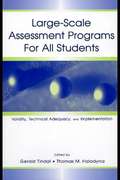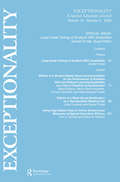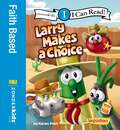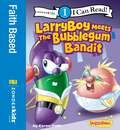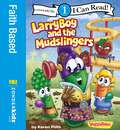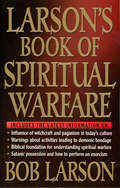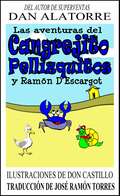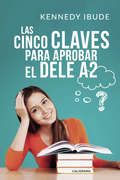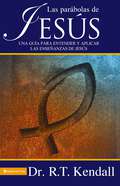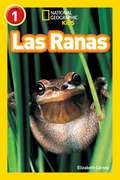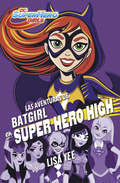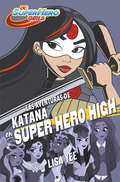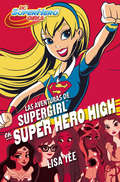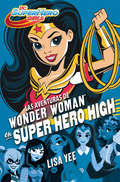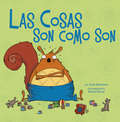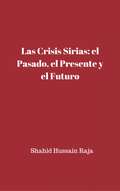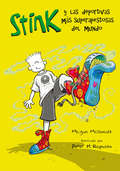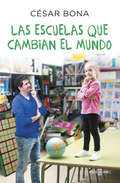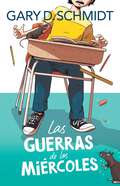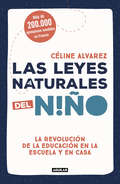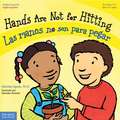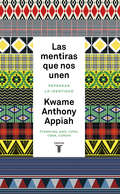- Table View
- List View
Large-scale Assessment Programs for All Students: Validity, Technical Adequacy, and Implementation
by Thomas M. Haladyna Gerald TindalThe need for a comprehensive volume that reviews both the processes and issues involved in developing, administering, and validating large-scale assessment programs has never been greater. These programs are used for many purposes, including instructional program evaluation, promotion, certification, graduation, and accountability. One of the greatest problems we face is how to deal with special needs and bilingual populations. Examining these processes and issues is the mission of this book. It is organized into the following five sections: Introduction, Validity Issues, Technical Issues, Implementation Issues, and Epilogue. Each chapter follows a common structure: Overview of critical issues, review of relevant research, descriptions of current assessment methodologies, and recommendations for the future research and practice. Written by nationally recognized scholars,Large-Scale Assessment Programs for All Students: Validity, Technical Adequacy, and Implementation will appeal to anyone seriously involved in large scale testing, including educators, policymakers, testing company personnel, and researchers in education, psychology, and public policy.
Large-scale Testing of Students With Disabilities: A Special Issue of exceptionality
by Gerald TindalLarge Scale Testing of Students With Disabilities addresses three issues: accommodations, modifications, and reporting of outcomes. The purpose is not to present an exhaustive summary of the research in these areas but to focus attention on how the issues are considered and empirically validated. The research summarized in this issue should serve as a model for state departments to consider in adoption of policy, either as findings upon which to inform policy or as a method to adopt in generating findings themselves. The studies reflect critical methodologies that are either experimental in design or use extant data sets as well as present a theoretical framework in how to interpret empirical results.
Larry Makes a Choice: Level 1 (I Can Read! / Big Idea Books / VeggieTales)
by Karen PothA Lesson in Doing the Right ThingWill Cowboy Larry take the long, hard road, or will he cheat and take the easy path during his cattle-drive test? Ride along to see how he realizes the importance of choosing to do what&’s right.This is a Level One I Can Read! book, which means it&’s perfect for children learning to sound out words and sentences. It aligns with guided reading level J and will be of interest to children Pre-K to 3rd grade.
LarryBoy Meets the Bubblegum Bandit: Level 1 (I Can Read! / Big Idea Books / VeggieTales)
by Karen PothA Lesson in Doing Your BestAll the residents of Bumblyburg are feeling lazy. Can LarryBoy save the day or will the Bubblegum Bandit take over Bumblyburg?This is a Level One I Can Read! book, which means it&’s perfect for children learning to sound out words and sentences. It aligns with guided reading level J and will be of interest to children Pre-K to 3rd grade.
LarryBoy and the Mudslingers: Level 1 (I Can Read! / Big Idea Books / VeggieTales)
by Doug PetersonA Lesson in Saying SorryA day at the water park turns messy for some Veggie friends. Can LarryBoy and Alfred lend a hand and save the day?This is a Level One I Can Read! book, which means it&’s perfect for children learning to sound out words and sentences. It aligns with guided reading level J and will be of interest to children Pre-K to 3rd grade.
Larson's Book of Spiritual Warfare
by Bob LarsonLarson's Book of Spiritual Warfare is a window into a world many Christians have no idea exists. An expert on the occult, cults and supernatural phenomena, Bob Larson provides a comprehensive guide to the motivating factors of much of the deviant behavior occuring in society today.
Las 8 verdades sobre Jesús: Hechos que nos dan esperanza
by Danilo H. GomesLa gran mayoría de los cristianos no conoce las 8 verdades fundamentales sobre Jesucristo. ¿Y tú… las conoces? ¿Quién es Jesús? Difícilmente encontraremos a alguien que no haya oído hablar de Jesús, pero la pregunta es: ¿Cuántos lo conocen realmente? Debemos abandonar urgentemente nuestra superficialidad en el conocimiento sobre Cristo para sumergirnos en su persona. Por mucho que haya divergencias dentro del cristianismo, hay 8 verdades bíblicas incuestionables sobre el Salvador. El libro LAS 8 VERDADES SOBRE JESÚS trata sobre estos 8 hechos que son la base de la fe cristiana. No es un resumen ni una reflexión, sino una visión edificante sobre la vida y la obra de Jesucristo. Renueva tu fe y enamórate del Hijo unigénito de Dios Padre. Aprende sobre: La eternidad de Cristo, su vida como hombre en el mundo, sus milagros y maravillas, su santidad, su muerte en la cruz, y otros temas.
Las Aventuras Del Cangrejito Pellizquitos Y Ramón D’Escargot
by Dan AlatorreLa familia de una niña va a la playa, donde ella se hace amiga de un cangrejito y de los amigos de este. Todo va bien hasta que, después de una tormenta, aparece en la orilla un pequeño extraño y la niña decide, con sus nuevos amigos, ayudarlo a regresar a casa... ¡en Francia!Disfruta con tu retoño de este libro para niños ilustrado a todo color. ¡Perfecto para leer a los pequeños o para que los niños algo más grandes te lo lean!
Las Cinco Claves para Aprobar el DELE A2
by Kennedy IbudeLas cinco claves para aprobar el DELE A2, examen. Las cinco (5) claves para aprobar el DELE A2, examen de nacionalidad. Un libro de nueva edición con mucha atención y revisado contundente. Es imprescindible para incrementar su nivel requerido; prepararte para aprobar el examen A2 está en tus manos.
Las Manzanas del Sr. Peabody
by Loren Long MadonnaEste libro está inspirado en un cuento de casi 300 años de antigüedad que me contó mi maestro de Kabbalah. El cuento vivió en mí durante mucho tiempo y, cuando empecé a escribir cuentos para niños, decidí que en uno de ellos transmitiría su esencia.
Las Parábolas de Jesús: Una guía para entender y aplicar las enseñanzas de Jesús
by R. T. KendallLas parábolas de Jesús Una guía para entender y aplicar las enseñanzas de Jesús El hijo pródigo, La semilla de mostaza, Las ovejas y las cabras … A través de estas y de docenas de otras parabolas, Jesús ayudó a sus discípulos -entonces y ahora- a entender las verdades acerca del reino de Dios. El autor desmenuza las sencillas historias de Jesús una por una y devela su profundo significado. Mientras el lector comienza a entender el propósito, la promesa y la paradoja de las parábolas conocerá de una manera fresca a aquel que las relató.
Las Ranas (National Geographic Readers #1)
by Elizabeth CarneyAprende todo sobre las ranas en este emocionante libro para niños en español.Está lleno de imágenes bellas e interesantes que les enseñan a los niños todo sobre estos animales asombrosos. Este libro de Nivel 1 es apropiado para los primeros pasos de lectura independiente o para una experiencia de lectura en voz alta, ¡perfecto para motivar a futuros científicos y exploradores!
Las aventuras de Batgirl en Super Hero High (DC Super Hero Girls #3)
by Lisa YeeEl insti no es nada fácil...¡Tener superpoderes todavía menos! Ponte la capa y descubre las aventuras de Batgirl en Super Hero High. Barbara Gordon siempre ha sido un cerebrito y un genio de la tecnología, pero no tiene superpoderes más allá de su mente prodigiosa y su memoria fotográfica. Sin embargo, cuando Supergirl se entera de sus habilidades, a Barbara le llega la oportunidad de su vida: una invitación para estudiar en Super Hero High, la escuela de élite para superheroínas. Por supuesto, Barbara no duda ni un segundo en aceptar el desafío de entrenar junto a las adolescentes más poderosas de la Galaxia y se convierte en Batgirl, la nueva chica del insti. Barbara siempre ha tenido el corazón de una heroína... pero ahora tendrá que demostrar que ¡lo es de verdad!
Las aventuras de Katana en Super Hero High (DC Super Hero Girls #4)
by Lisa YeeEl insti no es nada fácil...¡Tener superpoderes todavía menos! Ponte la capa y descubre las aventuras de Katana en Super Hero High. La espadachina Katana no es una adolescente normal... pero con amigas como Wonder Woman, Batgirl y Supergirl, ¡quién lo es! Además de entrenar como ellas para convertirse en una superheroína, Katana también sigue las nobles tradiciones guerreras de los Samurái. Pero Katana tiene mucho lío: acaban de nombrarla capitana del equipo de esgrima, tiene que entregar un trabajo megaimportante en el cole y debe luchar contra un villano que está reuniendo a un ejército... Con todo este jaleo, ¿cómo va a conseguir salvar a la humanidad?
Las aventuras de Supergirl en Super Hero High (DC Super Hero Girls #2)
by Lisa YeeEl insti no es nada fácil...¡Tener superpoderes todavía menos! Ponte la capa y descubre las aventuras de Supergirl en Super Hero High. Supergirl es la adolescente más poderosa de la galaxia, pero tras perder a su familia y su hogar en el planeta Krypton no tiene claro que Super Hero High sea el lugar ideal para ella... Tanto sus nuevos amigos como la simpática bibliotecaria del insti la han recibido con una cálida acogida, pero las pesadillas y villanos la atormentan. ¿Cómo se las arreglará para salvar el mundo? Supergirl es la nueva chica en el insti... ¡Y también en la Tierra!
Las aventuras de Wonder Woman en Super Hero High (DC Super Hero Girls #1)
by Lisa YeeEl insti no es nada fácil...¡Tener superpoderes todavía menos! Ponte la capa y descubre las aventuras de Wonder Woman en Super Hero High. Wonder Woman es una princesa que nunca ha salido de su hogar en Isla Paraíso, pero ha llegado el momento de convertirse en súper heroína y para eso tiene que ir a estudiar a Super Hero High. En el nuevo insti, Wonder Woman no solo tendrá que aprender a dominar sus poderes y superar entrenamientos muy exigentes, también deberá hacer nuevas amigas y lidiar con su compañera de cuarto, que se pasa el día posteando sus momentos más humillantes en internet... pero eso no es nada comparado con el hecho que Wonder Woman no ha visto a un chico en su vida. Ir al insti será mucho más difícil de lo que pensaba...
Las cosas son como son (Pasito a pasito)
by Julie GassmanMelvin tiene grandes rabietas cuando no consigue lo que quiere. Debe aprender a controlarse cuando sufre una decepcio´n. Al fin y al cabo, las cosas son como son y una rabieta no es la solucio´n.
Las crisis sirias: el pasado, el presente y el futuro
by Consuelo Cardozo Shahid Hussain RajaLas crisis sirias: el pasado, el presente y el futuro Shahid Hussain Raja http://www.amazon.com/dp/B0105VN8TS Desde que fuera redefinida como Medio Oriente por el Ministerio británico de Relaciones Exteriores y desde su división en más de una docena de estados nación, con todo y sus linderos artificiales, ya finalizada la Primera Guerra Mundial, la región ha estado en turbulencia, principalmente a causa de su reestructuración geográfica y social. Por tanto, lo que está ocurriendo en Siria es una instantánea de lo que está ocurriendo en todo el Medio Oriente, que, debido a algunos legados históricos, a su ubicación geoestratégica, a sus abundantes recursos y a políticas regionales/globales de poder, ha visto crisis tras crisis por alrededor de un siglo. Estas crisis han sido agravadas por el embate de la Primavera Árabe, las ambiciones iraníes de paridad nuclear con Israel, y la pugna por recursos. En el contexto más amplio de alineaciones regionales en raudo cambio, hay varios conflictos y guerras desarrollándose en el Medio Oriente que tienen causas profundamente enraizadas e implicaciones serias para la estabilidad regional y la seguridad mundial. Lo que está ocurriendo en Siria debe verse en este contexto. Después de presentar el trasfondo de la crisis general que engolfa el Medio Oriente, sus raíces históricas, sus varias dimensiones y los tipos de conflictos y guerras en curso en la región, el libro explica brevemente el perfil socioeconómico y político de Siria, sin cuya comprensión no podremos apreciar las realidades en el terreno y el contexto histórico de las actuales crisis sirias. Luego traza los orígenes de las actuales crisis sirias y enumera los intereses de cada potencia mundial, a saber, Estados Unidos de América, China y Rusia en la región en general y en estas crisis en particular. Asimismo, el libro trata en detalle los intereses de las potencias regionales, es decir
Las deportivas más superapestosas del mundo (Serie Stink #Volumen 3)
by Megan McDonaldDescubre al hermano de Judy Moody ¡Qué porquería! ¡Qué peste! ¡Qué hedor! Explora con Stink la Máquina de Vómitos, el Medidor de Eructos o los Pedos Musicales que se encuentran en la Exposición de Porquerías organizada por el Museo de Ciencias, y descubre con él que su nariz tiene increíbles poderes. Desde hace tiempo Stink está interesado en todo tipo de cosas pestilentes. En esta ocasión él y su mejor amiga ¡se presentan a un concurso de zapatillas apestosas! Así comienza Stink y las deportivas más superapestosas del mundo:¡Qué porquería!¡Qué peste!¡Qué hedor! Stink estaba encantado. Encantadísimo con el colegio. Iba a ser el mejor día de todos los del curso de segundo, el mejor día sin duda para la clase de Segundo D, quizá el mejor día en todo el mundo, y posiblemente el mejor día en toda su vida.
Las escuelas que cambian el mundo
by César BonaEl nuevo libro de César Bona nos invita a conocer de primera mano algunos de los casos maravillosos que están teniendo lugar en el ámbito educativo español, excelentes ejemplos de que la educación de nuestros hijos, la forma de enseñarles, puede hacerse de otra manera y, lo mejor de todo: funciona. Hay escuelas en España que están cambiando la educación. Escuelas que no están en Finlandia ni en Suecia; unas son públicas, otras rurales y algunas incluso están masificadas. Todas ellas son «Escuelas Changemaker» y están preparadas para liderar una verdadera transformación educativa. César Bona ha viajado por siete ciudades y pueblos siguiendo el camino de algunas de las escuelas que están luchando para que cada niño, niña y joven tenga la oportunidad de convertirse en un agente de cambio. Son lugares que cuentan con alumnos motivados, maestros corrientes, y padres cómplices detrás. Escuelas excelentes académicamente y conun proyecto integral donde el respeto, la creatividad, la imaginación, el trabajo en equipo, la empatía y la interacción con la sociedad son el mejor camino para completar las enseñanzas de las asignaturas tradicionales. César Bona nos narra, con su personal y cercana voz, lo que han logrado estas escuelas, lo novedoso de sus métodos y cómo todos, sea cual sea nuestra edad, podemos cambiar el mundo. No olvidemos que los niños no son los adultos del mañana, son los niños del presente y ellos, si les dejamos ser niños, si les reforzamos su creatividad natural, su imaginación desbordante y trabajamos la empatía, la solidaridad y el respeto, pueden cambiar el mundo. No en el futuro, sino ahora. Porque una nueva educación no es un sueño, es una realidad.
Las guerras de los miércoles / The Wednesday Wars
by Joanna WeaverNovela ganadora del Newbery Honor Holling Hoodhood está en problemas. Acaba de comenzar el séptimo grado con la señora Baker, y presiente que la maestra tiene algo en su contra. ¿Por qué otra razón lo haría leer a Shakespeare fuera del horario de clases? Es el año 1967, y todo el mundo tiene cosas más importantes de qué preocuparse. Por un lado, está Vietnam, y por otro está el negocio familiar. Según el padre de Holling, nada es más importante que el negocio familiar. De hecho, todos los Hoodhood tienen que comportarse siempre lo mejor posible: el éxito de Hoodhood y Asociados depende de ello. ¿Pero cómo puede Holling evitar los problemas si tiene que lidiar con la señora Baker?
Las leyes naturales del niño
by Céline AlvarezCéline Alvarez propone en este libro un nuevo sistema educativo que ya ha empezado a provocar un cambio pedagógico en Francia. Basado en los principios de la metodología Montessori y en los avances de la neurociencia, demuestra que el niño tiene unas capacidades innatas para aprender, solo hay que proporcionarle los estímulos y el ambiente adecuados y respetar sus leyes naturales. Todos los niños nacen con una capacidad innata para aprender y amar. Día tras día, la neurociencia nos descubre más sobre su increíble potencial. Sin embargo, por desinformación, les imponemos un sistema educativo inadecuado que entorpece su aprendizaje y no fomenta su bondad intrínseca. En Francia, más del 40% de los niños acaban la educación primaria sin haber cumplido con los objetivos de aprendizaje. En el caso de España la situación es todavía peor, pues tiene las tasas de fracaso y abandono escolar más altas de Europa: el 20% de los jóvenes no terminan sus estudios de secundaria. Céline Alvarez llevó a cabo un experimento en un parvulario en Gennevilliers, un municipio situado al noroeste de París y una zona con grandes desigualdades sociales y económicas. En este experimento, respetó las «leyes naturales del niño» y los resultados han sido excepcionales. En dos cursos, todos los niños del curso superior y el 90% del curso inferior sabían leer y mostraron excelentes resultados en aritmética. Y no solo eso, en casa estaban más tranquilos, mantenían sus habitaciones más ordenadas y mostraban mayor interés por cuanto los rodeaba. Increíble, pero cierto. Este libro sienta las bases de una nueva manera de ver al niño, y de concebir la educación tanto en casa como en la escuela. Céline Alvarez nos enseña su experiencia y nos invita a educar al niño respetando sus leyes naturales. La revolución de la educación es posible.
Las leyes naturales del niño: La revolución de la educación en la escuela y en casa
by Céline AlvarezCéline Alvarez propone en este libro un nuevo sistema educativo que ya ha empezado a provocar un cambio pedagógico en Francia. Basado en los principios de la metodología Montessori y en los avances de la neurociencia, demuestra que el niño tiene unas capacidades innatas para aprender, solo hay que proporcionarle los estímulos y el ambiente adecuados y respetar sus leyes naturales. Todos los niños nacen con una capacidad innata para aprender y amar. Día tras día, la neurociencia nos descubre más sobre su increíble potencial. Sin embargo, por desinformación, les imponemos un sistema educativo inadecuado que entorpece su aprendizaje y no fomenta su bondad intrínseca. En Francia, más del 40% de los niños acaban la educación primaria sin haber cumplido con los objetivos de aprendizaje. En el caso de España la situación es todavía peor, pues tiene las tasas de fracaso y abandono escolar más altas de Europa: el 20% de los jóvenes no terminan sus estudios de secundaria.Céline Alvarez llevó a cabo un experimento en un parvulario en Gennevilliers, un municipio situado al noroeste de París y una zona con grandes desigualdades sociales y económicas. En este experimento, respetó las «leyes naturales del niño» y los resultados han sido excepcionales. En dos cursos, todos los niños del curso superior y el 90% del curso inferior sabían leer y mostraron excelentes resultados en aritmética. Y no solo eso, en casa estaban más tranquilos, mantenían sus habitaciones más ordenadas y mostraban mayor interés por cuanto los rodeaba. Increíble, pero cierto. Este libro sienta las bases de una nueva manera de ver al niño, y de concebir la educación tanto en casa como en la escuela. Céline Alvarez nos enseña su experiencia y nos invita a educar al niño respetando sus leyes naturales. La revolución de la educación es posible.
Las manos no son para pegar (Best Behavior Series Bilingual Editions Ser.)
by Elizabeth Verdick Martine Agassi Marieka HeinlenLas mentiras que nos unen: Replanteando la identidad
by Kwame Anthony AppiahUn poderoso manifiesto contra la guerra de identidades, por uno de los más lúcidos pensadores contemporáneos. «Breve pero poderoso. Appiah desmantela elegantemente la farsa, el dogma y la propaganda que persisten en nuestros intentos de discutir la "identidad". Inspirador e imprescindible.»Zadie Smith Género, religión, raza, nacionalidad, clase y cultura. Estos conceptos nos definen y moldean nuestro mundo polarizado. Sin embargo, las identidades colectivas que generan están plagadas de contradicciones y falsedades. Al explorar su naturaleza y su historia -desde las engañosas ideas sobre la raza del XIX hasta los debates contemporáneos sobre «apropiación cultural»- Kwame Anthony Appiah se deshace de los mitos más venenosos y desmonta con lucidez nuestras ideas preconcebidas sobre cómo funcionan estas identidades. Todos sabemos que las identidades crean conflictos, pero Appiah revela cómo las identidades nacen del conflicto. Y demuestra también, entrelazando lúcidos argumentos, maravillosos ejemplos históricos y anécdotas personales en una narración vibrante, que nuestro preciado concepto de soberanía nacional es incoherente; que la idea misma de la cultura occidental es un espejismo deslumbrante; y, en definitiva, que no existe una esencia asociada a una determinada identidad social que explique por qué las personas son como son. Appiah, filósofo ghanés de madre inglesa y padre perteneciente a la etnia asante, está en una posición idónea para reflexionar sobre cosmopolitismo, pertenencia e identidad. Su libro es un manifiesto filosófico para el siglo XXI. La crítica ha dicho...«Inteligente y sutil, ligero y a la vez lleno de apreciaciones perspicaces.»Daniel Gascón, Letras Libres «Necesitamos más pensadores tan sabios como Appiah.»Anand Giridharadas, The New York Times Book Review (portada) «Las principales identidades de las culturas contemporáneas pueden ser erróneas. Hay mucho que aprender de esta espléndida obra.»Amartya Sen, premio Nobel de Economía «Excelente. Aunque la solución a la fractura de nuestro mundo sea inalcanzable, al menos este libro nos ayuda a ver con claridad el problema.»Clifford Thompson, The Washington Post «La tesis de este entretenido y serpenteante viaje es que las identidades son menos sólidas de lo que se suele pensar.»The Economist «Appiah nos invita a ceder ante la difícil tarea de vivir con complejidad, es decir, de ser modernos. Erudito, personal, oportuno y profundamente humano. Un libro para nuestro tiempo.»Arlie Russell Hochschild «Escritor elegante y pensador trascendente, Anthony Appiah revela la manipulación histórica de los estereotipos de color y raza. Nos conduce a replantearnos a qué tribu pertenecemos. Una genialidad y una lectura placentera.»Mary Karr, autora de El club de los mentirosos e Iluminada «Uno de los más relevantes escritores en temas como la identidad, la cultura y la diferencia. Con su marca registrada, sinónimo de claridad, elegancia y rigor, es un guía muy útil para pensar en algunos de los complicados problemas relacionados con quiénes somos y qué podemos ser.»Viet Thanh Nguyen, ganador del premio Pulitzer por El simpatizante
